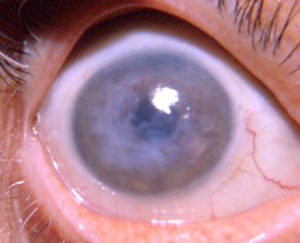Fuchs Dystrophy
Fuchs’ dystrophy is a rare disorder that affects the cornea. Although the cause of Fuchs’ dystrophy is unknown, it often occurs as an inherited disorder.
The cornea is made up of 5 layers. Fuchs affects the innermost layer of the cornea called the endothelium. The endothelium acts like a sump pump, removing excess fluid from the cornea. This helps the cornea maintain its transparency. But with Fuchs’ dystrophy, those endothelial cells slowly deteriorate and die off. As a result, fluid builds up and the cornea becomes thickened. This may cause swelling, cloudy vision, pain and loss of corneal clarity.

Treatment
In early stages, your doctor may prescribe eye drops, which help to control your symptoms by keeping the cornea thin. In later stages, and sometimes following cataract surgery, the cornea may thicken to the point that bullae, or cysts, form in the cornea. At this point, the endothelial cells have been overcome by excess fluid and can no longer maintain a thin, clear cornea. Eye drops will no longer function at this stage, and surgery is now necessary in order to replenish a normal layer of endothelial cells.
Surgical options include corneal transplantation (hyperlink) and a newer form of transplantation called DSEK (Descemet’s stripping endothelial keratoplasty). DSEK (hyperlink), instead of replacing the whole cornea, replaces only the inner layer. DSEK is becoming the mainstay of treatment, as it is less invasive and requires less healing time than a standard corneal transplant.



